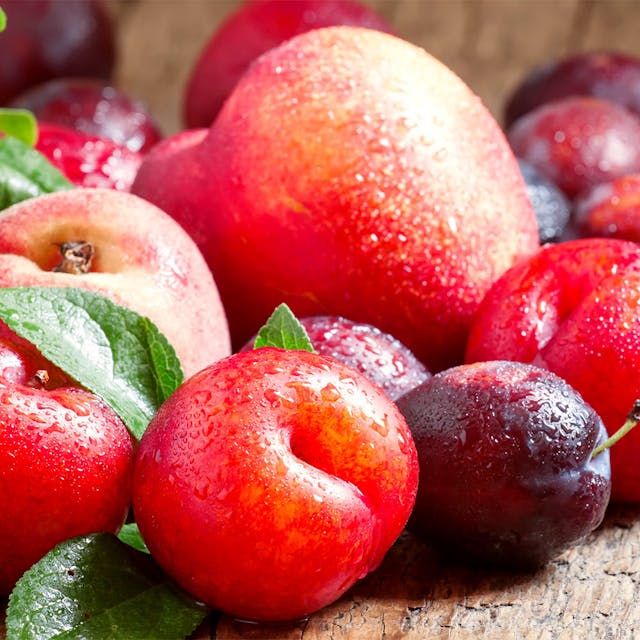Mark Slavonia | June 23, 2022
The Seedless Fruit Edition
On mutation, grafting, and botanical breakthroughs
Recommended Products

An excellent book about bananas.

A graft-derived fantastical fruit tree that can produce several different types of fruit.
Mark Slavonia (MJS) is an investor, a pilot, and an avid cyclist. He wrote about kitchen ballet, rowing machines, traveler’s checks, and more. He posts other things that are interesting on his website and on Twitter.
Mark here. It’s stone fruit season, my favorite time of year for fresh, seasonal fruit. There’s a row of trees behind my house that drop small, delicious plums more quickly than we can harvest them. Although I might prefer to eat these tiny treats unimpeded by their pits, the big, hard seeds of plums, apricots, and peaches have not yet yielded to efforts to cultivate seedless varieties.
The cherry-sized plums that grow in my backyard. The Seek app tells me these are “cherry-plums”
Why is this interesting?
There are several ways to develop and produce seedless fruit, but luck has yielded some of the best results. A chance mutation can create a variety that delays its seed production, one that produces tiny seeds, or one that has no seeds at all. For example, the navel orange—seedless and awesome—resulted from a happy accident discovered in Brazil around 1820. In the wild, this variety would be doomed. The lack of seeds means that they would produce no offspring.
The navel orange, a happy and seedless accident
But observant growers can rescue these mutants and reproduce them through grafting: where a cutting from the seedless tree is attached to a branch of an existing tree. If the tree varieties are similar and the arborist is skillful, the grafted branch can thrive and produce fruit on its new host tree.
If you’re not so lucky and your fruit isn’t so accommodating, you can help nature along by using several methods to encourage advantageous mutations to occur. For example, you can treat a plant with a chemical called colchicine, which can cause the plant to grow with double the usual number of chromosomes. Breeding the resulting doubled-chromosome plant with a normal plant can create sterile offspring incapable of developing seeds.
But there’s a catch. For some plants, the growth of delicious fruit is triggered only by the emergence of seeds. If the seeds don’t develop, the fruit doesn’t either—or the fruit becomes stunted and small. Such is the fate of existing seedless varieties of apples and watermelons.
The Spencer seedless apple. Get used to disappointment.
Stone fruit are especially intractable. Botanists haven’t yet developed or discovered a peach, cherry, or apricot that will develop a useful fruit without a big seed and its husk.
An apricot and its inescapable pit
Seedless varieties that are raised through grafting or cutting are genetic clones of each other, leaving them especially susceptible to blight or disease due to their limited genetic diversity. Such a fate ruined the commercial cultivation of the (seedless) Gros Michel banana in the 1950s. Up until that time, the Gros Michel was the top banana in the global banana trade, but the emergence of Panama Disease wiped out most Gros Michel plantations. Growers shifted to the Cavendish Banana, which is what most of us think of as a banana today. But the Cavendish banana could yet succumb to Panama Disease or a similar wipeout.
Gros Michel bananas, from Atlas Obscura/Chris Naka
None of the seedless fruit commonly on the market today is a genetically modified organism (“GMO”) in the modern sense. Seedless varieties are the result of old-fashioned botany, patience, and luck. While some fruits have been successfully bred to cultivate useful seedless varieties, the perfect seedless apple or pitless cherry is still elusive. Finding or cultivating one would be a botanical breakthrough. (MJS)
Quick Links:
Atlas Obscura goes searching for a Gros Michel banana
The ancient Romans had seedless grapes, probably, but the evidence is a single mention by Pliny the Elder
Grafting can produce fantastical fruit trees that produce several different types of fruit. If you don’t have the patience to do the grafting yourself, you can purchase a fruit cocktail tree.
—
WITI x McKinsey:
An ongoing partnership where we highlight interesting McKinsey research, writing, and data.
Resilience for sustainable, inclusive growth. Resilience is the ability to deal with adversity, withstand shocks, and continuously adapt and accelerate as disruptions and crises arise over time. A can’t-miss report from the World Economic Forum and McKinsey explores how public- and private-sector organizations can build a resilient stance.
—
Thanks for reading,
Noah (NRB) & Colin (CJN) & Mark (MS)
—
Why is this interesting? is a daily email from Noah Brier & Colin Nagy (and friends!) about interesting things. If you’ve enjoyed this edition, please consider forwarding it to a friend. If you’re reading it for the first time, consider subscribing (it’s free!).





